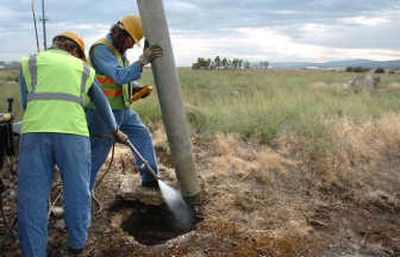City would buy parcel from itself

Three years after Spokane utility customers spent $6.3 million for a defunct horse track in hopes of building a future sewer plant, Spokane Mayor Dennis Hession and others want to sell most of the land at a loss.
The buyer? Spokane taxpayers.
Under the plan, which still needs City Council approval, the city would buy 45 acres of the former Playfair race track from its own utility division, which is the legal owner of the land, for $2.8 million, or $1.43 a square foot.
In 2004, the city’s utility division bought about 63 acres of Playfair for $6.3 million, or $2.29 a square foot.
At a City Council meeting earlier this week, Councilman Brad Stark questioned why the cost has fallen.
“I kind of scratch my head a little bit on that,” Stark said in an interview.
Administration officials say that the price, based on an appraisal completed last year, is fair.
“It has to pass muster with the state auditor’s office, and we believe it will,” Hession said.
State rules require that money raised by the utility departments through sewer bills and similar sources be used solely for utility purposes. Spokane leaders believe that using the land to promote job growth – the city’s goal for the land – would have to be completed using money from taxpayers, requiring a sale between city departments.
A portion of the higher price paid in 2004 resulted from city utilities paying the buyer, Appleway Leasing Inc., $500,000 to remove structures, including the grandstand, and asbestos from the site. Without considering those fees, city utilities paid about 30 percent more per square foot than the recent proposal.
Chief Operating Officer John Pilcher said the lower cost also reflects that the wastewater department would maintain a road easement on the 45-acre portion for access to 18 acres it would keep for storm water operations. It also would have easements giving the department permission to make noise and release odor from its remaining property.
Another factor, Pilcher said, is a commitment the city made to attempt to build experimental infrastructure desired by the utility division on the site. That could include building roads that allow rainwater to permeate to the soil and finding ways to make industrial use of treated wastewater. If the utility division sold the land to a private developer, those promises would be unlikely, Pilcher said.
Later this month, the Spokane City Council will consider using $150,000 from its 2006 surplus as a down payment on the property, plus $25,000 for a study on what to do with the land. If the city opts not to transfer the land after its examination, the city’s general fund would lose the down payment to its utility departments.
Stark said the city should not have to put a down payment on Playfair before it has a complete idea how it will use the land.
“I don’t see the urgency right now,” Stark said. “I question the need to spend $175,000. (The land) is not going anywhere.”
Pilcher said the down payment is designed to protect sewer and water ratepayers and was included at the insistence of utility officials. He added that it would be unfair to force the utility departments to hold onto the property without compensation while the city’s economic development department studies it.
The recent appraisal of Playfair, completed by Appraisal Group Northwest in Spokane Valley, doesn’t criticize the price the city paid for the land in 2004.
“The buyer appears to have paid a premium which was justified as they are a government entity, and they had strong motivation to tie up this site for the water treatment plant,” the appraisal said.
The city bought the land for a proposed wastewater plant it planned in coordination with Spokane County. But that concept was discarded and the county decided to go it alone using the former Stockyards property east of Playfair, which the county bought in 2004.
The recent Playfair appraisal report, which compares the Playfair land to 10 recent sales of industrial parcels, indicates that the county paid $4 a square foot for the Stockyards property, twice the appraised value of the land.